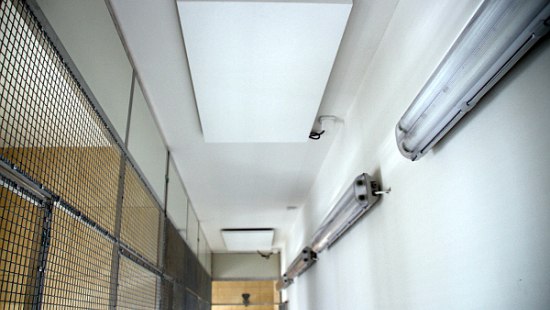Aviary with ULTRATHERM panels

Efficient aviary heating which doesn´t dry out the air too much or stir up dust? Try radiant panels
Two years ago, I was thinking about which method of heating to choose for the wintering area in aviaries I’m planning to build for macaws. There were several options, including various types of heating, and electric heating seemed the easiest (though perhaps not the cheapest). I also considered standard radiators placed along the service corridor. However, I know from practical experience that such radiators not only stir up dust but also become “dust magnets” over time, and they dry out the air in the room too much. At least, that was my experience with a bird room in a family home where the macaws for which we are building the aforementioned aviaries are being kept temporarily. After several visits to different Czech animal keepers, I chose to use a system of radiant panels placed on the ceiling in the wintering area.
I have read about radiant panels before in the magazine Nová Exota, but I first saw them “in the flesh” in Olomouc at the house belonging to the publisher of this periodical, Jan Sojka. I didn´t trust this design much at first. It seemed to me that the panels are too small and so would be unable to heat the wintering area reliably, particularly as macaws require a temperature of at least 10°C in the winter months when the outside temperature can drop far below freezing point. I was also worried that a really large number of these panels would be needed for the planned wintering place, which was supposed to have an area of 30 square metres and a volume of over 90 cubic metres. My mind was changed both by Jan Sojka, who I saw was only using two panels in a similarly large wintering place, but also by the electrician who installed electrical wiring in the aviary for me.
Ecosun low-temperature radiant panels
The electrician doesn´t keep parrots but he’s very familiar with radiant panels. He even has one of them on an enclosed balcony, allowing him to heat it in the winter and sit outside. I learned from him that one panel can heat a relatively large area, and that the heat which radiates mainly in the downwards direction from the panel spreads gradually across the whole room. Of course, if a panel were placed in the inside aviary above the perch, it could radiate too much onto the macaw sitting below, but I knew from the very beginning that if I chose this type of heating, I wouldn’t place the panels directly inside the flying area but rather install them above the service corridor, as I saw at Jan Sojka´s. I also had to find out how many of the panels would be needed for the wintering place, how much they would cost and how expensive their operation would be.
My first question was answered by a representative from Fenix, the company from which I ordered the radiant panels. All I needed to do was send the producer the internal dimensions of the room where I want to place the panels and they calculated that ideally four panels would be needed. This seemed to be a bit excessive to me; on the other hand, I learned later that this number is ideal for the heating of the given area to a room temperature of 20°C. I therefore decided to order three panels first and prepare a connection for another one or two in case they were needed in the future. I chose the low-temperature Ecosun 600 U radiant panel for my project. The size of this 6 cm thick heating unit is 62 x 112.5 cm. It also came with a grid for the attachment of the panel to the ceiling, and a cable for connection to an electrical socket.
What to consider before installation
We planned the places for the attachment of the panel together with an electrician and a bricklayer well in advance because the workers who were supposed to construct the plasterboard suspended ceiling in the wintering place had to take them into consideration. They cut out openings for electric sockets in precisely determined places and pulled the previously installed electrical wiring through them. The installation of the radiant panels wasn´t so difficult, though I was worried at the beginning as to whether the plasterboard would hold so much weight (one panel weighs almost 10 kg). Before the installation itself, we had to deal with the question of where to place the thermostat which reads the air and floor temperatures. It mustn´t be directly under the radiant panels, as this would have a negative effect on the measured values. As I planned to place the panels along the whole length of the ceiling of the service corridor (with the exception of one part where space has been left for a possible fourth panel), we had to choose one of the inner aviaries.
In the end, the Fenix TFT thermostat was “parked” in the last breeding compartment which divides the service corridor at the end of the wintering place. I’m not going to put parrots in that one until last. The thermostat is on the wall, at eye level, and the birds won´t be able to get to it at all because the closest perch and mesh are far enough away and the wall is completely tiled. Nevertheless, it is an emergency solution which will be very impractical when the aviary is occupied. However, I cannot but praise the thermostat itself. It is a relatively simple device with a touch screen on which several heating modes can be set. It counts operating hours and multiplies them by the average price of electricity per 1kWh (in Euros). You thus have constant control over how much you spend on heating. That is, if the panels are really operating. When the thermostat is set to a certain level of temperature but the panels’ circuit breakers are off, the device behaves as if the panels were heating and counts the electricity “burnt”.
The first real test - but still without birds
We installed the radiant panels in the autumn when the weather was still relatively good and temperatures were high so I didn´t have any reason to try them out for a long time. The first opportunity came around the end of November when the first frost appeared. It needs to be added that the wintering place was empty when the tests were conducted as I am still waiting for approval for the aviaries, without which I don´t intend to move the birds there. However, action was already required due to a complaint from the electrician who was getting extremely cold while finishing the last jobs needed in the wintering place. We agreed that even though the aviaries are empty, the structure shouldn´t be allowed to freeze during the winter. It was decided that it would be best if the temperature were maintained at 7°C, so I switched on one of the three panels, set the temperature to 7°C and waited to see what would happen.
The panel really started to radiate. It was clearly noticeable when walking under it, though it took the whole area (where the temperature had been around 2°C before) a few hours (until the next day) to heat up. Afterwards, the area remained at the selected temperature, as the thermostat always switched off the panel when the chosen temperature limit was exceeded by a certain amount, and if the temperature dropped to approximately 6.5°C, the device switched the panel on and heating began again. On some days, when the temperature was above zero outside, the thermostat didn´t even switch the heating on and it was possible to keep the temperature above 7°C. It is a shame that I am heating empty aviaries, but on the other hand, I am happy that I can try out the whole system before the parrots arrive and so avoid having to disturb them later by making changes or removing unexpected problems. The most critical practical test is awaiting me at the beginning of spring, when the aviaries will become “fully operational”. I will be happy to share my experiences afterwards once again.







